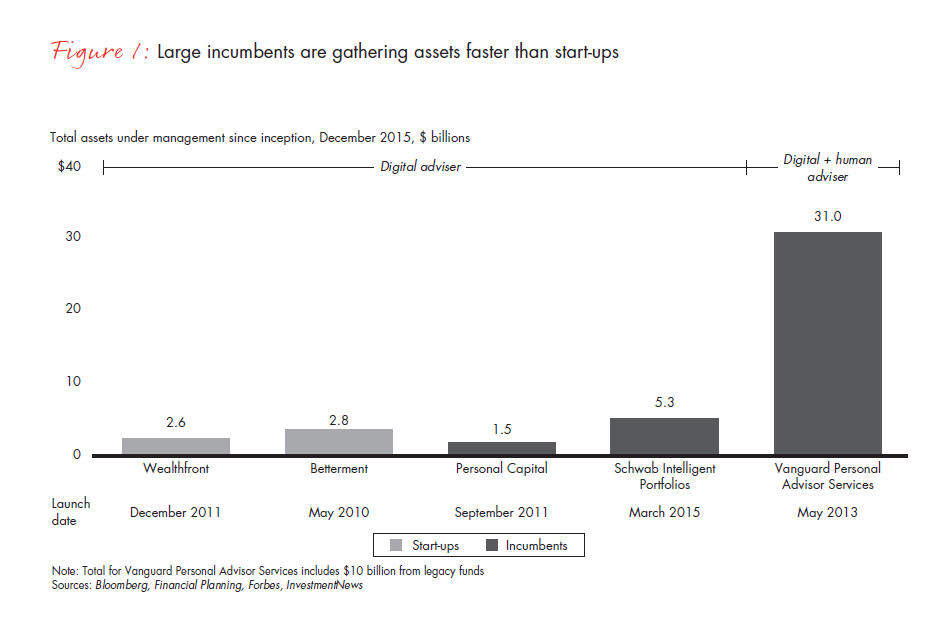Brief

Individual investors increasingly are looking for alternatives to the wealth management model that relies heavily on engaging clients in person. Many people want a more flexible way to manage their investments, which combines sophisticated, easy-to-use digital tools with a human touch when it really matters. Regulators have also been putting pressure on conventional commission-based models, eroding the economics of many traditional wealth management businesses.
Consumers’ appetites for alternative models, combined with powerful new software, have opened the door to a wave of “robo-adviser” start-ups, such as Betterment, Personal Capital and Wealthfront. These firms rely on automated computer algorithms to allocate, deploy and rebalance investments. They make it easy to open an account, and their active reporting not only helps people understand their financial positions but also nudges them to better investment behaviors—a critical factor in building a sufficient retirement nest egg.
Andrew Edwards, a partner in the Financial Services practice, discusses how robo advising can remove customer service hurdles and deliver better experiences to the client segments that need it the most.
These insurgents have themselves gained assets, and they have spurred investment giants such as Fidelity, Charles Schwab and Vanguard to develop their own fast growing robo offerings, often in a hybrid model that pairs digital tools with human advisers when needed (see Figure 1). With a large existing base of middle-income users, investment firms hope to appeal to more customers and lower their costs through more self-service.
Where does that leave insurance companies, wire houses, broker dealers and banks that have not yet adopted robo advice? They are at serious risk of losing share in the middle markets given relatively weak customer loyalty in their wealth management businesses and a high-cost distribution model that has seen little productivity growth in recent years. Fortunately, they still have time to convert existing customers—and possibly attract new ones—by heeding four lessons from the experience of early movers.

Use the trove of customer information to steer the right customers to a new model. Incumbent firms have a wealth of data about their customers’ income, spending and savings, as well as customer feedback on what annoys or delights them about their banking experience. They need to develop capabilities to mine that data so it can be used to select groups with the greatest potential for a robo investment model and to identify people experiencing an event with big financial implications, such as a divorce or the birth of a child, which creates an opportunity to reconsider providers.
Robo can reenergize the adviser network. Financial advisers value their existing relationships with clients. Depending on how advisers are compensated, a hybrid model could adversely effect their livelihood as well as harm their relationships with clients. The transition to a new model, then, must be smooth for both customer and adviser. In fact, many advisers welcome better technology that they can use with their customers to visualize different investment strategies. Even better, automating routine interactions such as change of address allows advisers to spend more time on higher value interactions, which should raise their productivity and compensation.
Don’t assume the current pricing structure should stay. The way a firm currently prices—for example, with fees on underlying assets or commissions on trades—might not suit a new robo model. Major mutual fund houses have different pricing structures, and some even make available parts of their offerings for free. Firms will need to consider which products or services they might cannibalize with a robo model so they can find new revenues to offset those losses.
Modernize the legacy IT stack. Most firms will have to update their existing IT, parts of which date back three decades, so they can deliver better customer experience. Bain’s recent benchmarking of about 250 companies in Europe and North America found that digital leaders excel in three areas. They prioritize ruthlessly and eliminate noncritical IT projects, which result in more streamlined innovation agendas. They adopt Agile development processes and cloud infrastructure to speed delivery and reduce costs. And finally, they take a blank-sheet approach to self-funding, because this reexamines what IT does and how it does it.
A hybrid robo business model, executed well, will quickly appeal to a portion of the broad middle market of customers. As the technology improves, more customers will find value in this model. There’s no reason incumbent firms should cede the market to start-ups or to mutual funds.
